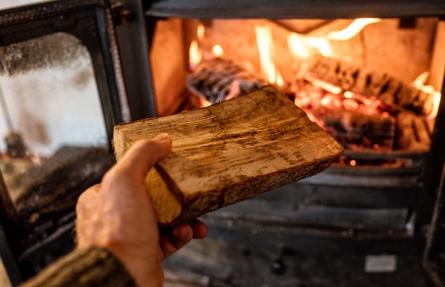As winter sets in and temperatures drop, many homeowners turn to wood stoves as a reliable heat source. However, if not properly maintained and used, wood burners can pose a serious danger to your home. According to the National Fire Protection Association (NFPA), heating equipment is the second leading cause of house fires in the United States.
At ServiceMaster Restoration by FUSON, we understand the devastating effects a house fire can have on families and their homes—we've seen it firsthand. We're here to share some of the most common mistakes homeowners make with wood stoves and what to do instead:
1. Using Unseasoned or Wet Wood
Wondering why your wood stove produces more smoke than heat? The answer could lie in the type of wood you're burning. Unseasoned or wet wood contains high levels of moisture, which can lead to a smoky fire that produces less heat and more creosote buildup in your chimney. This buildup can increase the risk of a chimney fire, spreading quickly to other parts of your home.
It's important to use well-seasoned wood. Seasoned wood has been cut, stacked, and dried for at least six months, reducing its moisture content to below 20%. You can also use a moisture meter to check the wood before burning it.
2. Overfilling the Stove
While you may want to pack the stove to warm things up quickly, overfilling the stove with wood can actually be dangerous. When too much wood is packed in, it prevents proper airflow and can cause the fire to smolder and produce more smoke. This creates a buildup of creosote, leading to chimney fires, and increases the risks of hot embers escaping when the stove door is open.
To avoid this mistake, start slow and steady. Wait until your fire starter, kindling, and first few logs have burned down before adding more wood. Understanding how to use the damper and air vents on your stove can also help control the fire's intensity.
3. Using Poor Fire Starters
There are some things you want to remember NOT to put in your stove, no matter how tempting it may seem. Poor fire starters that can create a dangerous fire include:
- Treated wood
- Lighter fluid
- Gasoline or kerosene
- Paraffin firelighter logs
- Compressed combustibles like wood briquettes
These will either create a fire that burns too hot or produce toxic fumes, both of which can damage your stove and pose a risk to your health. Instead, dry kindling or newspaper make perfect fire starters. If you're using manufactured logs, make sure they are specifically designed for wood stoves
4. Leaving Combustibles Near the Stove
While you'll want to make sure your wood stove is installed properly and meets local codes, which include keeping it three feet away from combustible surfaces and using proper flooring, it's also important to keep any combustible materials safe from the stove.
This includes the wood you’re using to fuel the fire and any flammable items like furniture, curtains, or decorations. These can catch fire if they touch a hot stove or a stray ember. Regularly check around your wood stove and keep the area free of combustibles.
5. Neglecting Proper Cleaning and Ash Management
Annual chimney cleaning and maintenance is crucial, but it's also important to regularly clean your wood stove. This includes removing any ashes and creosote buildup inside the stove at least once a week, depending on how often you use the stove. Creosote is highly flammable, so keeping your stove clean lowers the risk of chimney fires and improves efficiency, producing more heat with less smoke.
When removing ashes, it's crucial to wait at least 24 hours after use, as they can remain hot for days. Place the ashes in a metal container with a tight-fitting lid and store it outside or in a non-combustible area away from your home, keeping them away from any combustible or flammable materials.
6. Ignoring Warning Signs of Fire Risks
Even with the best maintenance and care, wood stoves can still pose a fire risk. That's why it's essential to be aware of any warning signs that your burner may not be functioning properly. These include:
- Excessive smoke or soot buildup
- Difficulty starting the fire
- Flames shooting out of the chimney
- Unusual noises or smells from the stove
If you notice any of these signs, stop using your wood stove immediately and contact a professional for inspection and repairs! This will keep you and your home safe from potential fire hazards.
Keep Your Home Safe from Wood Stove Fire Danger
Wood stoves provide excellent winter warmth when used properly. By avoiding these mistakes, you can ensure safe operation and a cozy home all season. Always follow manufacturer guidelines and schedule professional maintenance. If you experience fire damage in the Midland area, ServiceMaster Restoration by FUSON offers expert 24/7 fire damage restoration services.
Have you experienced fire or smoke damage from a wood stove? Contact us anytime for professional restoration services!


